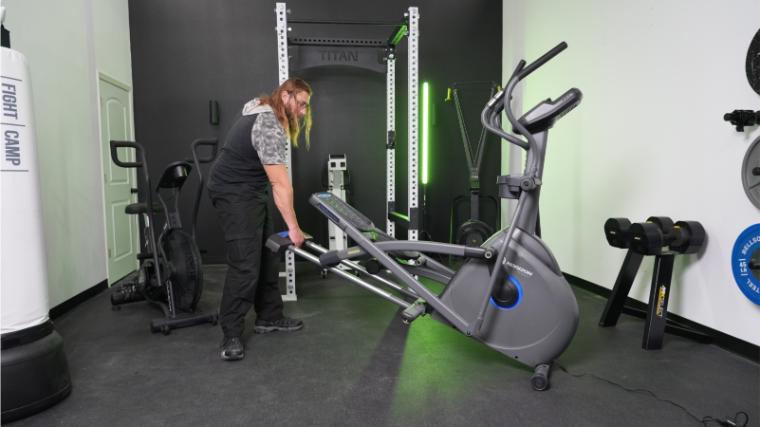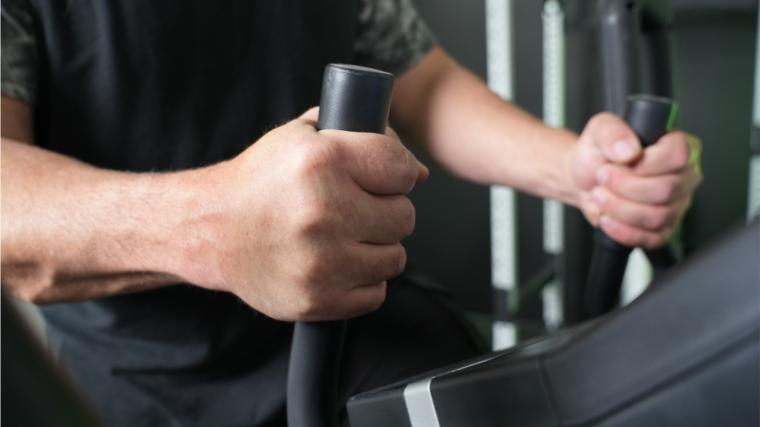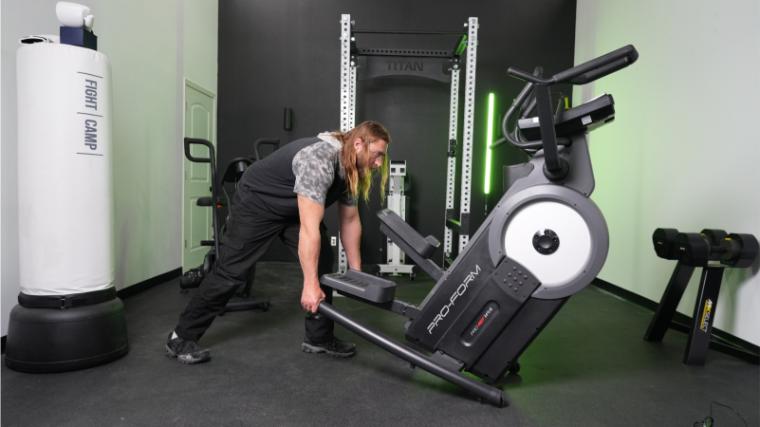Moving an elliptical can be tricky because, as BarBend expert reviewer Amanda Capritto, CPT, CES, CNC, CF-L1, CSNC notes, many of the best ellipticals are heavy and hard to move by yourself: “Ellipticals come in a wide range of sizes. Higher-end models are generally very heavy and can be unsafe for one person to move on their own.”
With that said, it’s not impossible to move these exercise machines; it just takes thorough planning to prevent any damages to the equipment or your home. In this guide, we’ll discuss how to move an elliptical and if you need to disassemble it first. Continue reading as we also detail what supplies are needed for a safe move and when it’s time to hire a moving company.
Moving an Elliptical Machine in 7 Steps
Moving an elliptical requires planning and preparation in order to safely transport your exercise machine. Whether it’s within the same room or to a new home, check out the following steps on how to properly move an elliptical trainer.
Read Owner’s Manual
The first step to moving your elliptical is to read the owner’s manual. There, manufacturers will suggest the best course of action for moving this cumbersome fitness machine. Based on their guidelines, you may have to disassemble the entire machine.
The rest of these steps are based on moving an elliptical with minimal disassembling.
[Related: How To Clean Ellipticals]
Map Out Your Path
Failing to prepare is preparing to fail, and if you fail to properly plan out the best course of action for moving your elliptical, you will certainly fail in epic fashion. The destination will shape how best to move it.

For example, moving up or down stairs, narrow hallways or doorways, and floor surfaces like carpet or tile will impact how you secure, load, and move the elliptical. If possible, try to map a route that avoids narrow pathways and sharp turns. If you can’t bypass these in-home variables, you may be better off disassembling the machine or hiring movers.
Unplug and Remove Components
Make sure you unplug the power cord and secure it to the machine with a zip-tie. If you have a modern elliptical, then there might be additional components to remove, like speakers, cupholders, and screens. Place any screws from these components into a Ziploc bag so none fall by the wayside during the move.
Secure Moving Parts
Unlike the best treadmills, ellipticals have moving parts that can swing when trying to load the machine on a dolly or wheel it around the house. The arms and foot pedals need to be firmly secured with rope, tie-down straps, or ratchet ties to prevent any swinging during transportation.

During my time as a personal trainer, I’ve seen many people try to move this gym equipment without strapping down the handrails and feet first. After bruised shins and a few smacks to the face, securing these moving parts became the primary emphasis going forward.
Get Some Help
On average, ellipticals weigh around 150 pounds, though there are models — including many of the best ellipticals with incline — that weigh over 200 pounds. The combination of weight, size and swinging parts make it extremely difficult to move an elliptical on your own, even if it’s in the same room.
It’s highly recommended that you get some help moving this exercise machine, especially if it’s to a new residence, up a flight of stairs, or through a path with a lot of sharp turns. If you don’t have any help, we’d suggest hiring movers.
Load and Move Elliptical
Even if your elliptical has transport wheels, it will still likely need a furniture dolly for transporting to its destination. Once you’ve removed the smaller components and secured the swinging parts, cover the elliptical with a moving blanket and strap it to a dolly. Make sure you lift this workout equipment with your legs and not your back. The last thing you want to do is suffer an injury while performing this heavy lifting.

Once on the dolly, you can wheel the machine to another room on the same floor of your house or to a moving truck for transportation. If you’re moving an elliptical up or down stairs, this could require several assistants to carry the machine, as a dolly is not advisable to use on stairs.
Set Up Elliptical
Once your elliptical has reached its final destination, go ahead and carefully unstrap the machine from the dolly. Make sure your helper is there to keep the machine from tipping over while separating it from the dolly. Untie the rope or cord from the arms and feet, reattach any removed components, and plug in the power cord. Turn on your home gym equipment to make sure it’s working properly and then prepare to reap your elliptical’s benefits.
To Disassemble or Not to Disassemble
One of the biggest challenges of moving an elliptical is knowing when to disassemble the machine. There are numerous factors that go into determining whether or not you should disassemble an elliptical. Let’s take a closer look at some of them.
When to Disassemble
Here are a few situations in which it may be advantageous to disassemble your elliptical:
- It’s too big or heavy to move and you don’t have sufficient help
- There are multiple flights of stairs to navigate
- The doorways and hallways are too narrow for the machine or dolly
Before disassembling this expensive piece of exercise equipment, consult your owner’s manual to make sure that you aren’t violating the warranty by taking it apart. Additionally, the manual may also have instructions on how to properly disassemble your elliptical for transportation.
Whenever you disassemble an elliptical, make sure you put the screws, pegs or other small pieces into a Ziploc slider bag to secure them. Additionally, label the bag so that you don’t get confused when trying to put the machine back together. We also recommend that inexperienced elliptical owners take photos or videos before disassembling.
[Related: Best Ellipticals For Small Spaces]
When Not to Disassemble
Do not disassemble if it will violate your warranty. Triple-check the manufacturer’s warranty for any clauses that prohibit disassembling. Additionally, if you are only moving the machine to another spot in the room or on the same floor of your home, then you probably won’t need to disassemble it. Just make sure to properly secure the power cord and moving parts, along with firmly strapping the elliptical to a dolly.
What You’ll Need to Move an Elliptical Machine
Moving an elliptical can require tools and supplies whether you are disassembling it or transporting it as is. The following items, which can be purchased at Amazon or a local hardware store, may be needed to properly move your elliptical.
- Screwdriver or Allen wrench: A screwdriver or Allen wrench may be required to remove smaller components or disassemble larger pieces.
- Ziploc Slider Bags: Ziploc bags could be useful to place screws, nails, pegs, and other small items that could easily be lost in a move. The slider Ziploc bags are preferred due to a quick and secure fastening of the plastic bag.
- Zip Ties: Zip ties are the preferred choice over packing tape for securing the power cord and any other cables. When removing, tape can leave an unwanted residue on the cord or machine.
- Moving Straps: Moving tie-down straps are ideal for tying down larger parts — like handlebars and foot pedals — that swing when lifting an elliptical.
- Furniture Blankets: Furniture blankets will not only keep your machine from getting dirty or scuffed during the move, but they also add extra padding just in case you bang into a wall or door frame. An inexpensive alternative would be bubble wrap.
- Furniture Dolly: Unless you are going up or down stairs, a furniture dolly is a must for moving an elliptical due to the weight and size of these exercise machines.
When to Hire Movers
Hiring movers to pack up and transport your elliptical machine could be a sensible option if any of the below applies to your situation.
- The machine is heavier than average — many of the best commercial ellipticals can weigh more than 200 pounds.
- You lack the proper tools to disassemble the machine.
- You lack the supplies to safely move it.
- There’s no one around to lend you a hand with transport.
- You have health issues that limit your mobility, strength, balance or coordination
Final Word
Having an elliptical in your home is a great way to improve your health and cardio levels. Unfortunately, if you need to move it for any reason, it can be rather challenging. Moving an elliptical requires planning, supplies, help, and maybe even a mover.
Before committing to updating your home’s decor or moving to a new residence, make sure to thoroughly map out how best to transport the elliptical and set aside some money for moving supplies. Use our moving tips above to plan ahead and prevent any potential damages to your machine or home gym.
FAQs: How to Move an Elliptical
Can ellipticals be folded?
Yes, some ellipticals can be folded — we actually have a list of the best folding ellipticals we’ve tested. Consult the owner’s manual if you are unsure whether or not your elliptical can fold. Do not try to disassemble or fold the machine prior to checking the manufacturer’s guidelines and warranty.
Can you take an elliptical apart to move it?
Before taking apart an elliptical, make sure you read the owner’s manual first. This guide may contain information about how to safely disassemble your elliptical. Additionally, the manual will state whether or not disassembling your machine violates the warranty.
Where should I put my elliptical in my house?
One of the most important things to consider before buying an elliptical machine is where to put it in your home. Most brands state in their guidelines and warranties to place the elliptical in a climate-controlled environment like a bedroom or den. Do not put an elliptical outside, near water, in a damp basement, or in a non-climate-controlled space like the garage. Storing an elliptical in these places can result in violating the warranty and potentially cause damage to your machine.